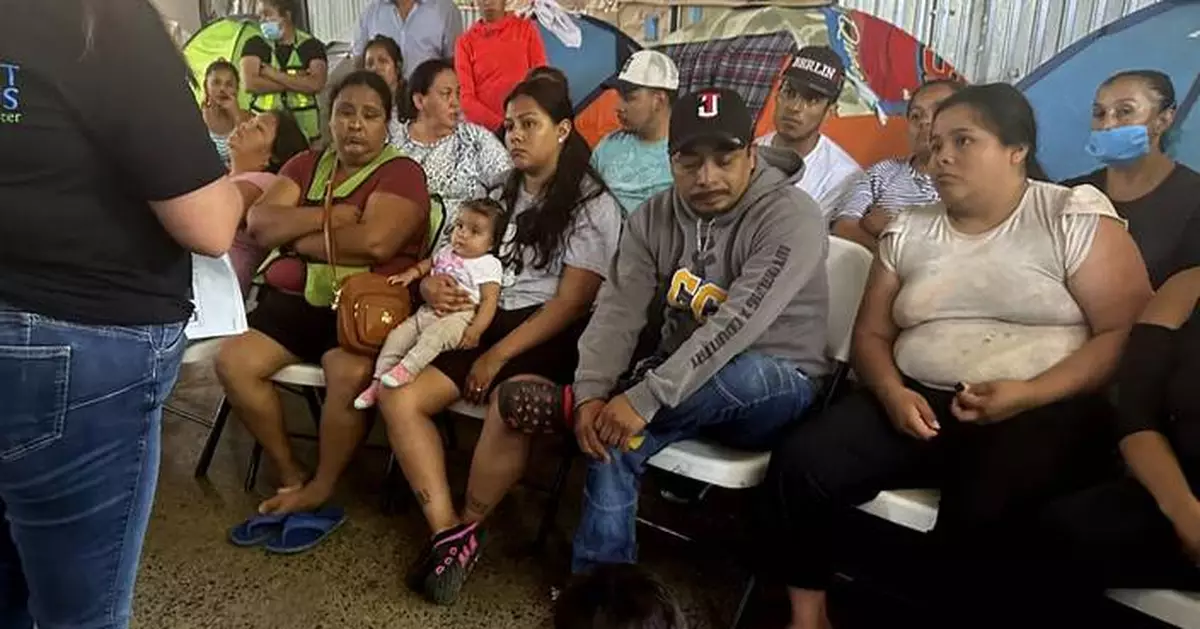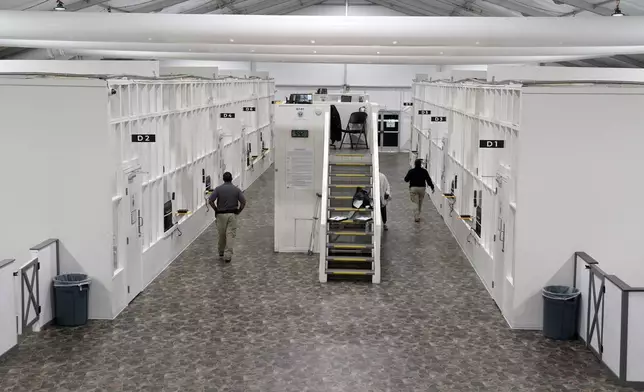TUCSON, Ariz. (AP) — Posters inside a complex of giant, white tents tell migrants in English, Spanish, Mandarin and Hindi they should tell an officer if they fear being deported and “your claim will be heard.” On a side wall where migrants are seated in a processing area, a video conveys the same message on a loop.
Breaking from a practice in effect since 1997, Border Patrol agents at the holding facility in Tucson, Arizona, and throughout the country no longer ask migrants if they fear deportation. President Joe Biden’s administration temporarily suspended asylum at the border June 5 and, as part of that move, agents do not ask about fears. Migrants must bring it up themselves.
Click to Gallery
TUCSON, Ariz. (AP) — Posters inside a complex of giant, white tents tell migrants in English, Spanish, Mandarin and Hindi they should tell an officer if they fear being deported and “your claim will be heard.” On a side wall where migrants are seated in a processing area, a video conveys the same message on a loop.
FILE - A group of men are escorted in a Border Patrol processing center, Friday, Dec. 15, 2023, in Tucson, Ariz. (AP Photo/Gregory Bull, File)
Christian Gutierrez, 26, center sits with other Mexicans who were deported from the United States to Tijuana, Mexico, on Tuesday, June 11, 2024. (AP Photo/Elliot Spagat)
Melissa Shepard, directing attorney of Immigrant Defenders Law Center, explains the Biden administration's new asylum restrictions to migrants at the Juventud 2000 shelter in Tijuana, Mexico, on Monday, June 17, 2024. (AP Photo/Elliot Spagat)
FILE - Women wait in a Border Patrol holding facility Friday, Dec. 15, 2023, in Tucson, Ariz. (AP Photo/Gregory Bull, File)
FILE - Agents walk among rooms at a Border Patrol holding facility on Dec. 15, 2023, in Tucson, Ariz. (AP Photo/Gregory Bull, File)
Melissa Shepard, left, directing attorney of Immigrant Defenders Law Center, explains the Biden administration's new asylum restrictions to migrants at the Juventud 2000 shelter in Tijuana, Mexico, on Monday, June 17, 2024. (AP Photo/Elliot Spagat)
Immigration advocates call it the “shout test” — suggesting migrants must shout their fears — though agents are taught to respond to other signs of distress, such as crying, shaking or a change in tone of voice and to refer migrants for screening if the behavior appears genuine. Anyone not screened can be immediately deported.
It is unclear to what extent the “shout test” is responsible for a decline in border arrests of more than 50% since asylum was halted, a welcome development for Biden as he faces Republican attacks of letting the border spiral out of control.
But administration officials said it is a critical change because migrants are more likely to say they fear deportation if prompted with a question.
Homeland Security Secretary Alejandro Mayorkas said strong guidelines are in place for agents to identify migrants exhibiting any signs of fear. Posters at holding facilities explain the new procedures and videos are shown at larger ones, such as Tucson.
“We train, we refresh the training, we are in constant dialogue with our personnel," Mayorkas said in an interview. “We are abiding by our international and humanitarian obligations.”
If they pass screening at a higher standard, migrants can stay in the U.S. to pursue protections similar to asylum, like those under the United Nations Convention Against Torture. In doing so, the administration argued it is complying with U.S. and international law prohibiting sending people to countries where they face persecution or torture.
Immigration advocates say migrants showing signs of fear can easily be overlooked. The Center for Gender & Refugee Studies, which has sued the administration over the asylum halt, said 51 of the 97 families it interviewed in 2020, when the “shout test” was briefly in effect during the COVID-19 pandemic, said they spoke to agents about fears of deportation and another 21 expressed nonverbal cues but none were screened.
Araceli Martinez, 32, told The Associated Press that she feared returning home with her 14-year-old daughter to a physically abusive husband, but no one asked her at the Tucson facility about why she came and she didn’t know that she had to speak up until it was too late. She was deported to Nogales, Mexico, last month.
Another Mexican, Christian Gutierrez, said he told officials he wanted to claim asylum during three days in custody in San Diego but it was futile.
“They completely ignored me,” Gutierrez, 26, told the AP while sitting on a bench in Tijuana, Mexico, after being deported. “They didn't give me an opportunity.”
Those who consider Biden's policies too soft play down the “shout test” — and the asylum halt broadly — as too little, too late. Robert Law, director for homeland security and immigration at the America First Policy Institute, said the test may have limited impact but not for long.
“Eventually the word will get out to those who are coaching those who are trying to take advantage of the asylum system,” said Law, who dealt with asylum as chief of policy at U.S. Citizenship and Immigration Services during former President Donald Trump's administration.
Even those who get a screening interview face new hurdles. Aside from higher standards, they get four hours to call an attorney from a holding facility, compared to a previous 24-hour window to prepare.
Those who don't have attorneys get a list of free legal service providers. The four-hour windows are from 7 a.m. to 7 p.m. including weekends, when many providers don't answer phones. Even on weekdays, they may be overwhelmed.
On a Saturday morning after asylum was halted, a woman's voicemail began calmly with her name, birth date, email address, booking number and date of arrest for crossing the border illegally with her 6-year-old daughter. After a 20-second pause, she started to cry, “Why? Why? Why? My God, please.” A guard asked if she was finished and she said yes.
RAICES, a group providing free legal advice to migrants in Texas that obtained the voicemail, found the woman in custody days later after she failed the screening but was waiting on an appeal. An immigration judge reversed the decision, saying she should have been interviewed in her native language, not Spanish, and that her fear was justified. She was released to pursue her case in heavily backlogged immigration courts.
A 22-year-old woman from Guatemala with a year-old son told her attorney she didn't understand the video instructing migrants to express any fears of being deported and felt confused and scared. She said she contacted RAICES when the Border Patrol gave her a list of attorneys after failing the screening.
The woman told the attorney in a recorded phone call that she fled to the U.S. to work and escape “those cartels." Fighting tears, she said her son had barely eaten in days.
“He wants to walk, he wants to go out and play games, but they won't let him,” the woman said. An immigration judge denied her appeal and she was deported with her son.
RAICES said it has been able to respond to 74 of 1,215 calls received from people in Border Patrol custody since asylum was suspended June 5. The organization provided recordings from their clients to the AP on the condition that their names and other identifying information not be published due to concerns for their safety.
In Tijuana, the Immigrant Defenders Law Center, which provides free legal advice to migrants detained in San Diego, has been spreading word of the changes. Directing attorney Melissa Shepard said callers seeking help often have only an hour left to prepare for their interview.
“You are the one who has to say I'm afraid,” Shepard said at a migrant shelter last month. The audience appeared to listen closely but didn't ask questions.
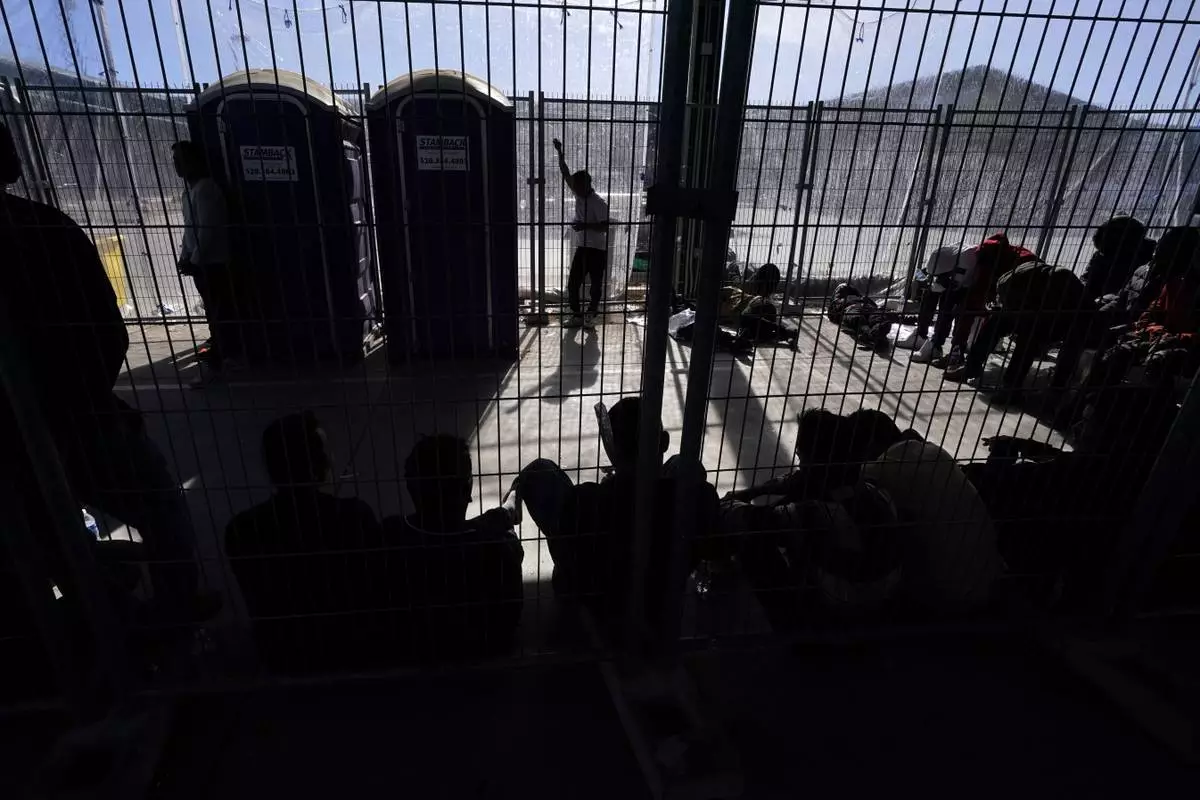
FILE - Men wait in a holding area Friday, Dec. 15, 2023, at a Border Patrol station in Ajo, Ariz. (AP Photo/Gregory Bull,File)
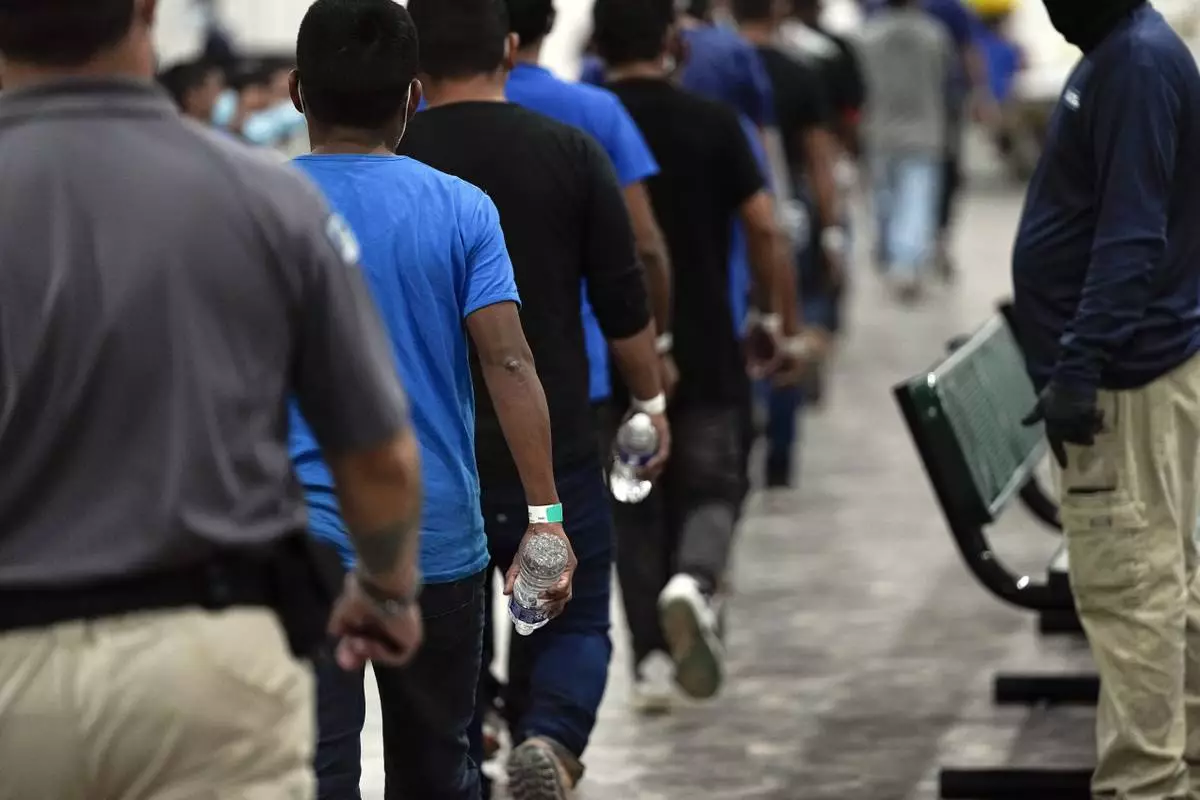
FILE - A group of men are escorted in a Border Patrol processing center, Friday, Dec. 15, 2023, in Tucson, Ariz. (AP Photo/Gregory Bull, File)
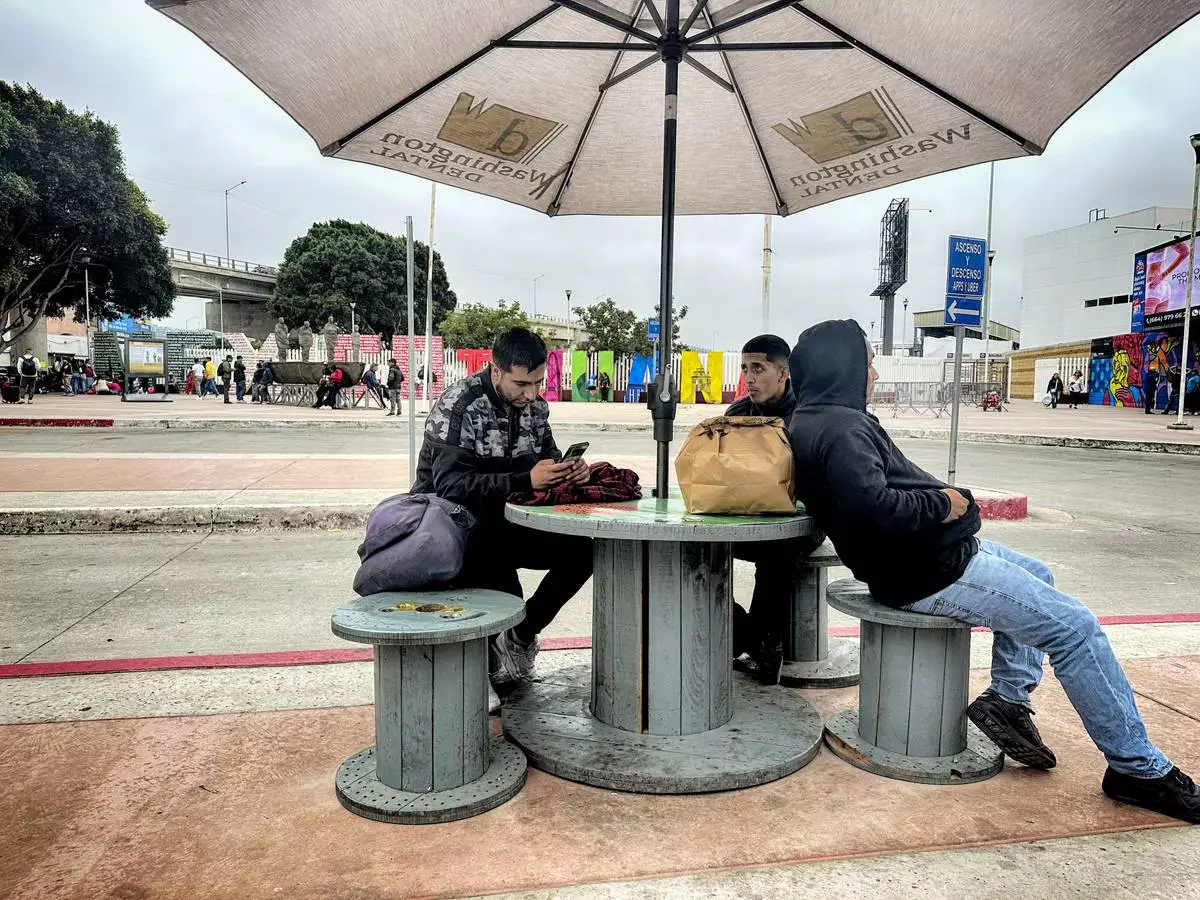
Christian Gutierrez, 26, center sits with other Mexicans who were deported from the United States to Tijuana, Mexico, on Tuesday, June 11, 2024. (AP Photo/Elliot Spagat)
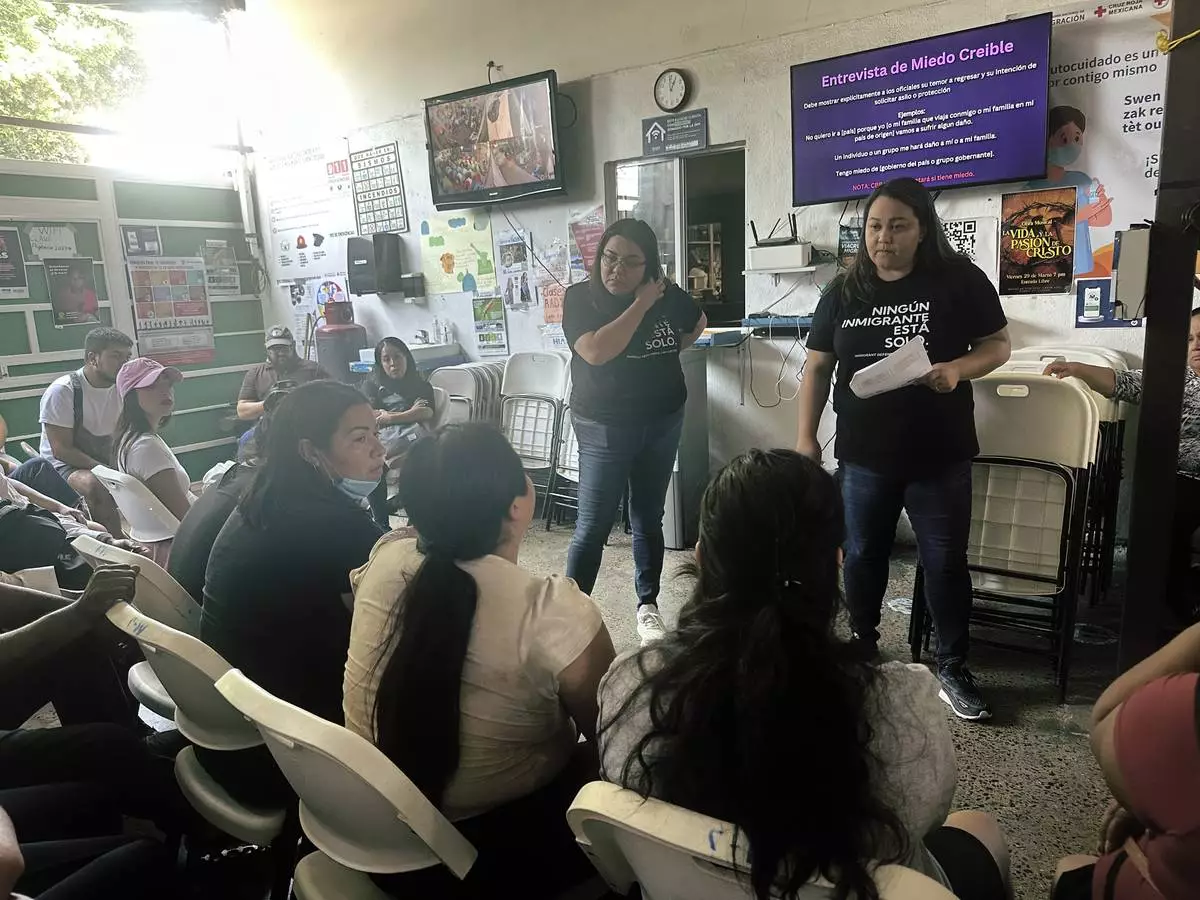
Melissa Shepard, directing attorney of Immigrant Defenders Law Center, explains the Biden administration's new asylum restrictions to migrants at the Juventud 2000 shelter in Tijuana, Mexico, on Monday, June 17, 2024. (AP Photo/Elliot Spagat)

FILE - Women wait in a Border Patrol holding facility Friday, Dec. 15, 2023, in Tucson, Ariz. (AP Photo/Gregory Bull, File)

FILE - Agents walk among rooms at a Border Patrol holding facility on Dec. 15, 2023, in Tucson, Ariz. (AP Photo/Gregory Bull, File)
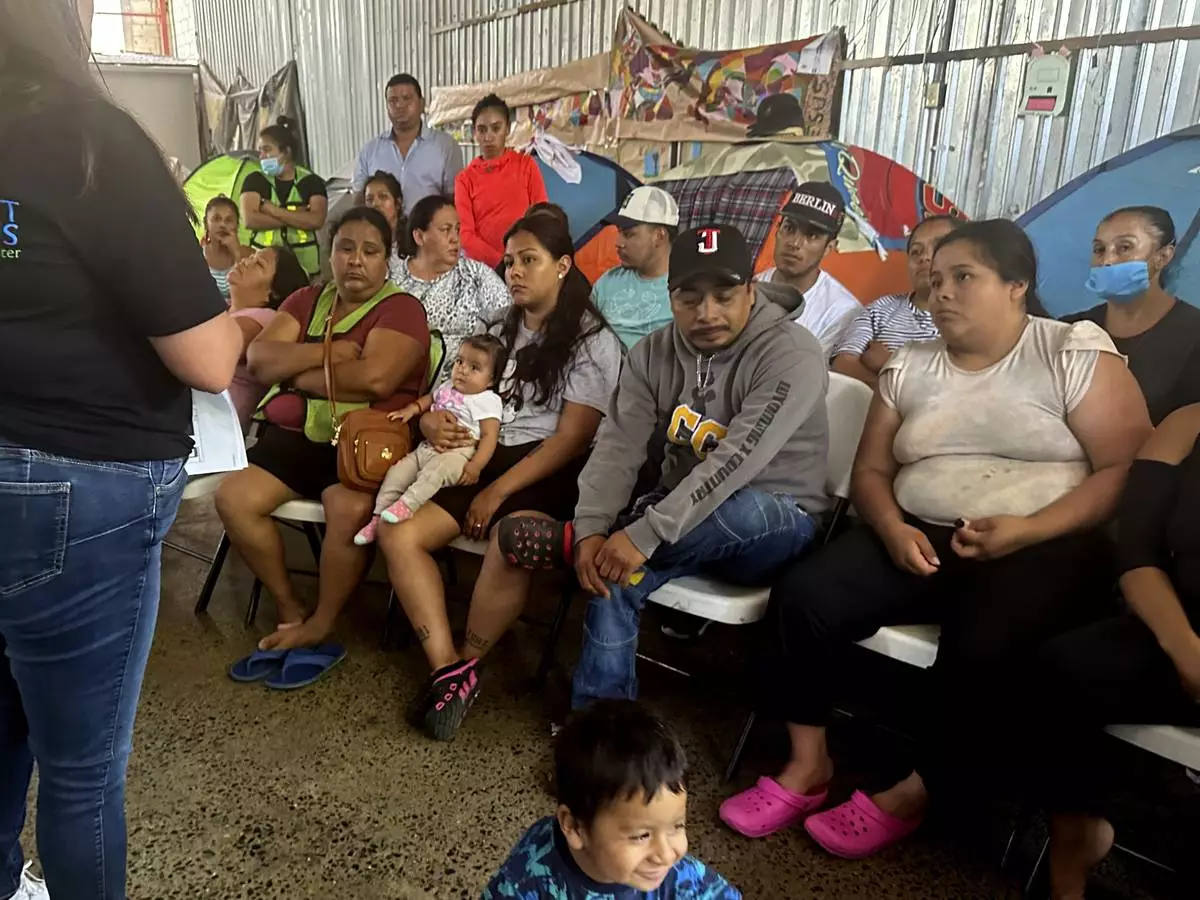
Melissa Shepard, left, directing attorney of Immigrant Defenders Law Center, explains the Biden administration's new asylum restrictions to migrants at the Juventud 2000 shelter in Tijuana, Mexico, on Monday, June 17, 2024. (AP Photo/Elliot Spagat)
NEW YORK (AP) — A mural honoring ancient and modern figures in medicine that has hung in the lobby of Pfizer’s original New York City headquarters for more than 60 years could soon end up in pieces if conservationists can’t find a new home for it in the next few weeks.
“Medical Research Through the Ages,” a massive metal and tile mosaic depicting scientists and lab equipment, has been visible through the high glass-windowed lobby of the pharmaceutical giant’s midtown Manhattan office since the 1960s.
But the building is being gutted and converted into residential apartments, and the new owners have given the mural a move-out date of as soon as Sept. 10.
Art conservationists and the late artist’s daughters are now scrambling to find a patron who is able to cover the tens of thousands of dollars they estimate it will take to move and remount it, as well as an institution that can display it.
“I would ideally like to see it as part of an educational future, whether it’s on a hospital campus as part of a school or a college. Or part of a larger public art program for the citizens of New York City,” said art historian and urban planner Andrew Cronson, one of the people trying to find a new home for the piece.
The 40-foot-wide and 18-foot-high (12 meters by 5.5 meters) mural by Greek American artist Nikos Bel-Jon was the main showpiece of Pfizer’s world headquarters when the building opened a few blocks from Grand Central Terminal in 1961, at a time when flashy buildings and grand corporate art projects were a symbol of business success. He died in 1966, leaving behind dozens of large brushed-metal works commissioned by companies and private institutions, many of which have now been lost or destroyed.
In recent years, Pfizer sold the building — and last year moved its headquarters to a shared office space in a newer property. The company said in an emailed statement that it decided the money needed to deconstruct, relocate and reinstall the mural elsewhere would be better spent on “patient-related priorities.”
The developer now turning the building into apartments, Metro Loft, doesn't want to keep the artwork either, though it has been working with those trying to save the piece with help like letting art appraisers in. The company declined to comment further, but Jack Berman, its director of operations, confirmed in an email that it needs to get the mural out.
Bel-Jon’s youngest daughter, Rhea Bel-Jon Calkins, said they’ve gotten some interest from universities who could take the piece, and a Greek cultural organization that could help fundraise for the move. But the removal alone could cost between $20,00 and $50,000, according to estimates cited by Cronson.
If they can’t immediately find a taker, the mural won’t end up in landfill, Bel-Jon Calkins said. But it would have to be broken up into pieces — nine metal sections and eight mosaic sections — and moved into storage, likely with some of her relatives.
Time is ticking away. Workers gutting the building have been carrying out ripped-up carpeting, drab office chairs and piles of scrap wood and loading them into garbage trucks.
For the past few decades, the artwork's metal — brushed tin and aluminum panels in the shape of laboratory beakers, funnels and flasks, surrounded by symbols, alchemists and scientists — has been a dull gray and white. But Bel-Jon Calkins remembers its original, multicolored lighting scheme.
“As you moved, the color moved with you and changed. So there was a constant dynamic to the mural that no one really has ever been able to achieve,” she said.
Richard McCoy, director of the Indiana nonprofit Landmark Columbus Foundation, which cares for local buildings and landscapes, said the piece might lack commercial value, describing Bel-Jon as “extraordinary, but not super well-known.”
“But then you realize 20 or 30 years from then how great it was,” he said, adding that it might merit preservation for its historical value.
Bel-Jon Calkins tracks her father’s 42 large-scale metal murals in a spreadsheet and on the artist's website. She said only about a dozen are confirmed to exist.
A 12-foot (3.6-meter) metal mosaic depicting saints and commissioned by a Greek Orthodox church in San Francisco was destroyed in the Loma Prieta earthquake of 1989. General Motors commissioned a hubcap-shaped metal mural that was larger than a car for a trade show, but she confirmed it was later melted down into scrap.
“It’s the corporations that have lost them,” she said in a phone conversation from her home in San Miguel de Allende, Mexico. “They valued them enough to commission them but not enough to preserve them.”

This undated photo shows the massive "Medical Research Through the Ages" mural at Pfizer's 1961 world headquarters in New York with its original multicolored lighting setup. (Rhea Bel-Jon Calkins via AP)
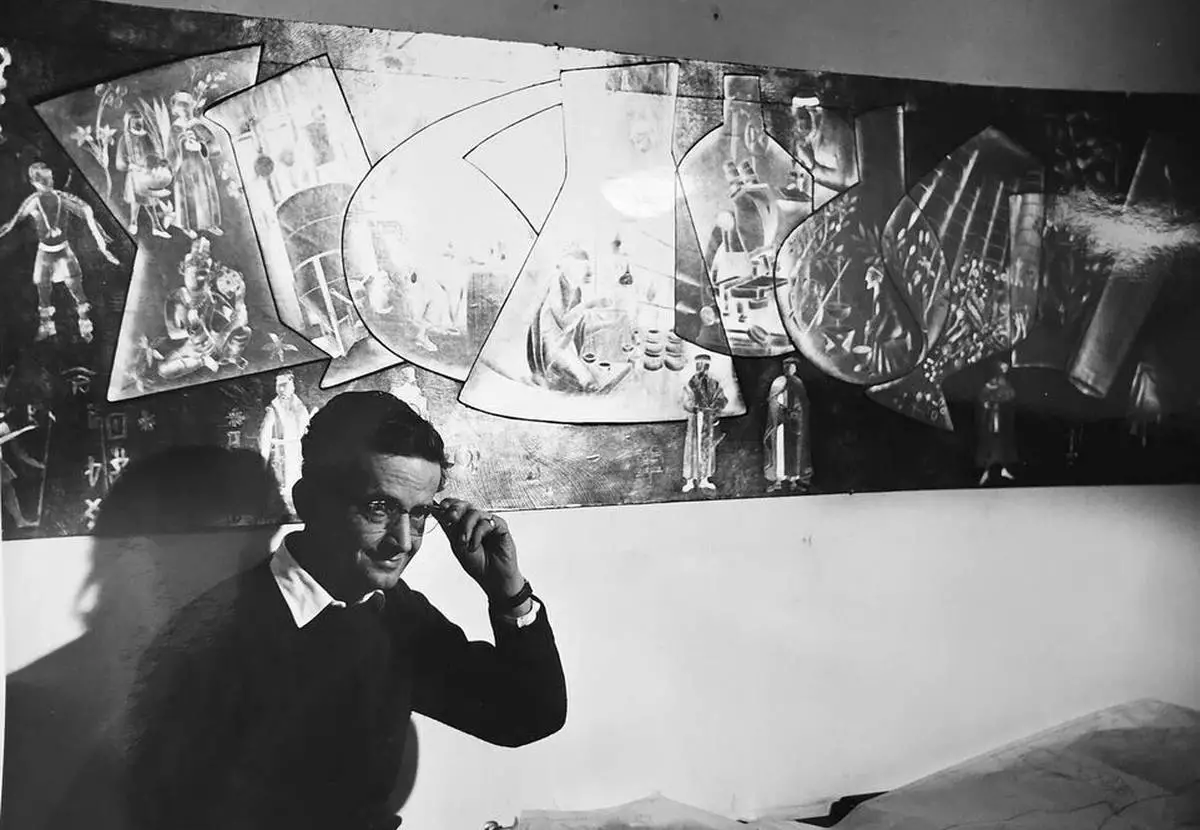
This undated photo shows Nikos Bel-Jon in his New York Studio on East 72 Street in front of a model of the massive metal mural he built for Pfizer's world headquarters in 1961. (Rhea Bel-Jon Calkins via AP)
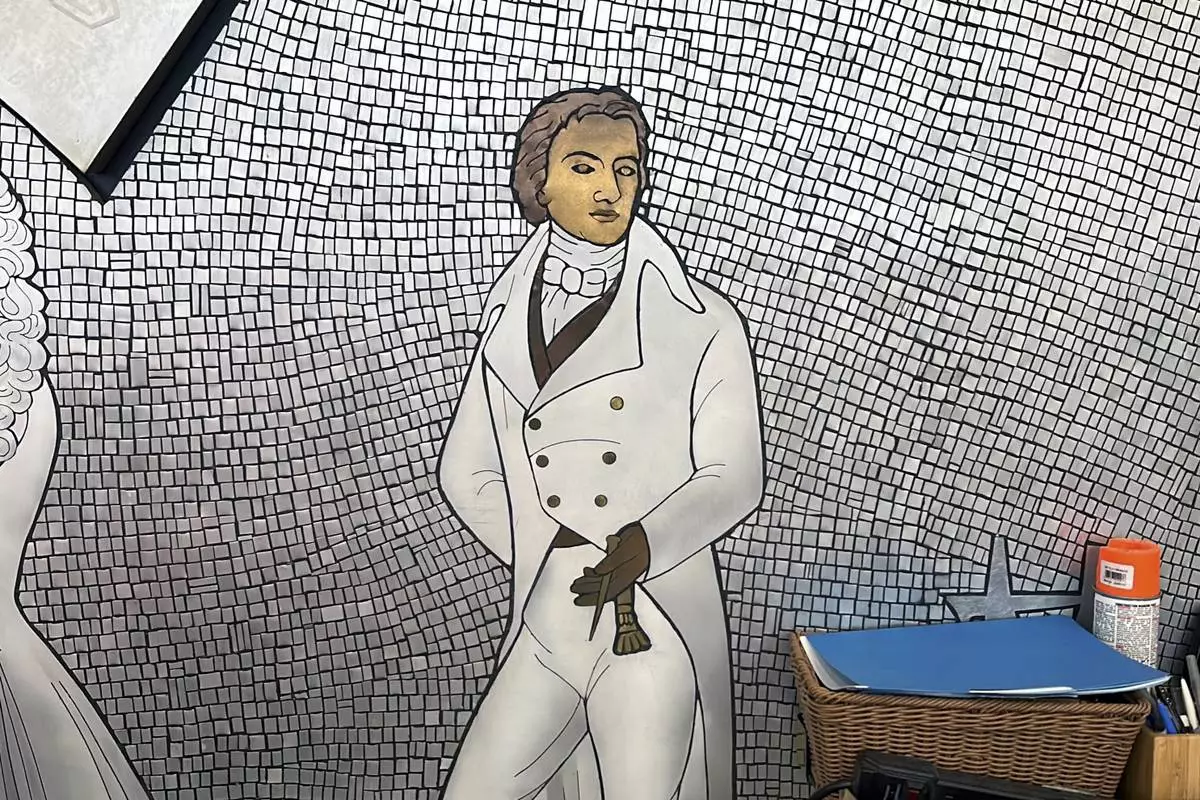
An image of Dr. Edward Jenner, who discovered a vaccine for smallpox, is part of a metal mosaic mural created in 1960 by Greek-born artist Nikos Bel-Jon titled "Medical Research Through the Ages," seen in the lobby of the old Pfizer headquarters in New York on Thursday, August 29, 2024. (AP Photo/Ted Shaffrey)
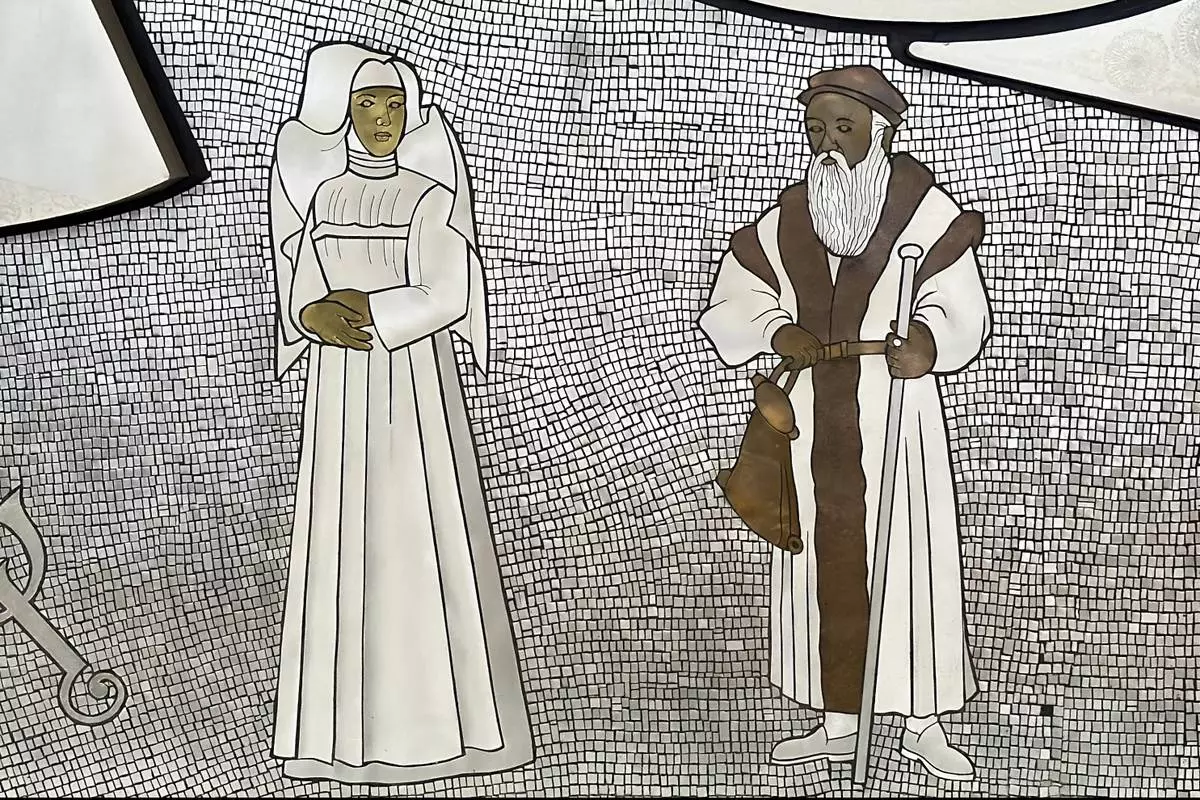
An image of a Sister of St. Martha, representative of women who devoted their lives to nursing the sick; and an image of Andres Vesalius, known as the founder of modern anatomy; are part of a metal mosaic mural created in 1960 by Greek-born artist Nikos Bel-Jon titled "Medical Research Through the Ages," seen in the lobby of the old Pfizer headquarters in New York on Thursday, August 29, 2024. (AP Photo/Ted Shaffrey)

Images, from left, of Horus, Egyptian mythology god; Emperor Shen-Nung; Hippocrates; and Doctor of Salerno; are part of a metal mosaic mural created in 1960 by Greek-born artist Nikos Bel-Jon titled "Medical Research Through the Ages," seen in the lobby of the old Pfizer headquarters in New York on Thursday, August 29, 2024. (AP Photo/Ted Shaffrey)

A metal mosaic mural created in 1960 by Greek-born artist Nikos Bel-Jon and titled "Medical Research Through the Ages" is in the lobby of the old Pfizer headquarters in New York on Thursday, August 29, 2024. (AP Photo/Ted Shaffrey)









